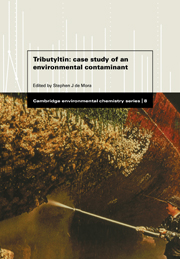Book contents
- Frontmatter
- Contents
- Contributors
- Preface
- 1 The tributyltin debate: ocean transportation versus seafood harvesting
- 2 Industrial manufacture and applications of tributyltin compounds
- 3 The analysis of butylated tin compounds in the environment and in biological materials
- 4 The occurrence, fate and toxicity of tributyltin and its degradation products in fresh water environments
- 5 The distribution and fate of tributyltin in the marine environment
- 6 Biological effects of tributyltin on marine organisms
- 7 TBT-induced imposex in neogastropod snails: masculinization to mass extinction
- 8 Environmental law and tributyltin in the environment
- 9 The efficacy of legislation in controlling tributyltin in the marine environment
- Index
Preface
Published online by Cambridge University Press: 04 August 2010
- Frontmatter
- Contents
- Contributors
- Preface
- 1 The tributyltin debate: ocean transportation versus seafood harvesting
- 2 Industrial manufacture and applications of tributyltin compounds
- 3 The analysis of butylated tin compounds in the environment and in biological materials
- 4 The occurrence, fate and toxicity of tributyltin and its degradation products in fresh water environments
- 5 The distribution and fate of tributyltin in the marine environment
- 6 Biological effects of tributyltin on marine organisms
- 7 TBT-induced imposex in neogastropod snails: masculinization to mass extinction
- 8 Environmental law and tributyltin in the environment
- 9 The efficacy of legislation in controlling tributyltin in the marine environment
- Index
Summary
Tributyltin (TBT) compounds are extremely poisonous, an attribute that has seen them utilized as the active ingredient in marine anti-fouling paint formulations. The potency of TBT ensures good fuel efficiencies during ship operation and long lifetimes between repainting for both boats and structures used in mariculture. However, its extreme toxicity has resulted in numerous adverse biological effects on non-target organisms, of particular importance being the shell deformations observed in oysters and the masculinization of female marine snails. The environmental persistence of TBT ensures that such problems are likely to continue for some time to come. In the first instance, this book describes the manufacture and industrial applications of TBT compounds, reviews their distribution and behaviour in the environment, and summarises their deleterious effects on organisms and aquatic ecosystems.
The widespread use of these anti-fouling paints has meant that TBT has become a contaminant of global concern. Many countries have taken diverse steps to regulate the use of TBT-based products in order to protect coastal and fresh water ecosystems, together with their resources. The political response to this pollutant has been notably faster and more widespread globally than that shown towards other pollutants in the environment, such as lead, for example, despite the fact that public health was never threatened. The steps taken have not been without controversy, considering the economic advantages to shipping on the one hand and the ecological damage on the other hand.
- Type
- Chapter
- Information
- TributyltinCase Study of an Environmental Contaminant, pp. xv - xviPublisher: Cambridge University PressPrint publication year: 1996



